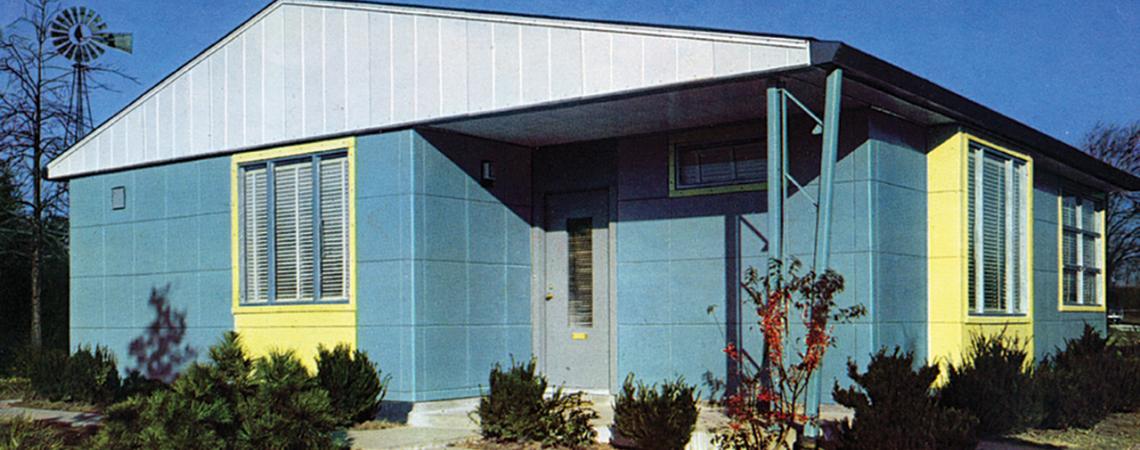Columbus-based Lustron Homes filled a need for housing when veterans began returning at the end of World War II. The company built more than 2,600 homes that were shipped across the country and around the hemisphere. (Photo courtesy of Ohio History Connection)
The headlines in late 1950 looked grim for our boys on the front lines in the Korean War — and for the Ohio-based Lustron Corporation.
Literally, side by side, you could read newspaper columns across the country about Marines and soldiers facing the coldest winter imaginable as they sought to liberate South Korea from the Communist aggressors, and about the Lustron Corporation facing ruin as it was pushed out of the burgeoning post-World War II housing market. Both made national news.
The Lustron story is one of innovation, entrepreneurship, and political chicanery. Let’s rewind another four years. World War II had just ended, and some 12 million U.S. veterans were coming home, only to face a housing shortage. Lustron Corporation tried to fill that need with modern homes that were prefabricated in Columbus, then sent to points both nearby and far away.
Prefabricated, or “kit,” homes weren’t necessarily a new thing in the late 1940s. Sears and Roebuck had been selling mail-order bungalows for decades.
But Lustron stood apart. Conceived in the wellspring of the mind of industrialist Carl Sandlund, Lustron was to build a better home to house young, postwar families both efficiently and quickly. Sandlund had experience, as he had built prefabs in the commercial market for use as White Castle restaurants and Standard Oil gas stations.
Anyone over 50 years of age may remember some of those buildings for the uncommon materials with which they were built: ceramic and steel.
And so were Lustron homes. Sandlund envisioned his company producing, en masse, modular homes made of glass-coated steel panels. They would be on the small side for young, small families — starter homes, available in gray, blue, yellow, or tan, with white trim. Sandlund secured $37.5 million in funding through the Reconstruction Finance Corporation, a federal agency designed to kick-start industry where central planners thought it was needed most.
Housing was one such market in need. Sandlund found the perfect spot to manufacture the kits: the recently abandoned Curtiss-Wright Aviation factory near Port Columbus airport that had supplied the military with aircraft during World War II. Sandlund outfitted the vast space with steel presses and ceramic coating apparatus and as much automation as he could use to create an assembly line akin to how cars were made in Detroit.
Much like how cars were sold then and today, the metal houses were put up for sale through local dealers. Sandlund built model homes in 100 cities east of the Rockies and offered dealers market exclusivity to their geographic area. At its apex in productivity, several hundred people worked at the Lustron plant in Columbus. More folks were employed shipping the homes to their concrete pads in Suburbia, USA, in specially crafted semi trucks.
An entire 900-square-foot all-metal house, in some 3,000 pre-wired and pre-plumbed parts, could be cobbled together in a matter of days, certainly less than three weeks. The first houses went up in 1947, many around Ohio, but many more in points beyond and some as far away as Alaska, New Mexico, Florida, and Venezuela.
Despite the novelty and innovation, the endeavor was to be short-lived. Meddling by staffers in the Reconstruction Finance Corporation, and other factions who wanted a cut of the pie, proved deadly for Sandlund’s glass-coated Lustron homes. The last houses came off the assembly line in late 1950. Instead of continuing to oversee the manufacture of homes, Sandlund and others were called before Congress in a series of hearings to determine how the government loan was spent. The hearings were the harbinger of the end.
The Reconstruction Finance Corporation called in Lustron’s loans, and the plant shuttered. In the end, only 2,680 metal houses rolled off the assembly line and onto the delivery trucks.
But Lustron lives. The midcentury moderns persist in places such as Xenia, Findlay, Columbus, and Whitehall. The Ohio History Center, near the state fairgrounds in Columbus, has a Lustron on display, as a demonstration of American life in the 1950s. Another Lustron, a blue one, is on display at Whitehall Community Park, preserved by the Whitehall Historical Society.
These glass-coated houses stand as monuments to another time — a precinct in Ohio history.









